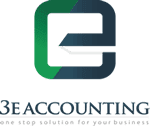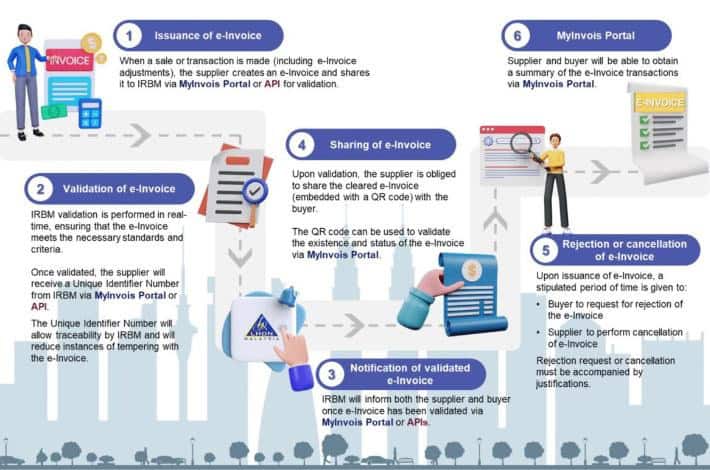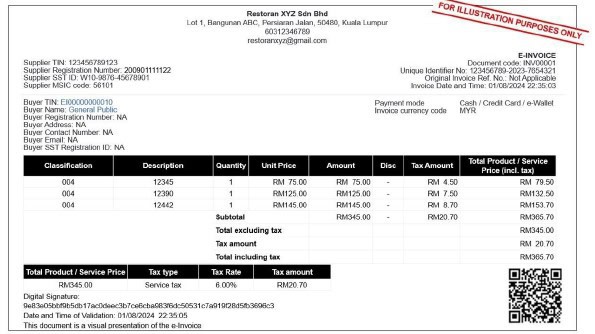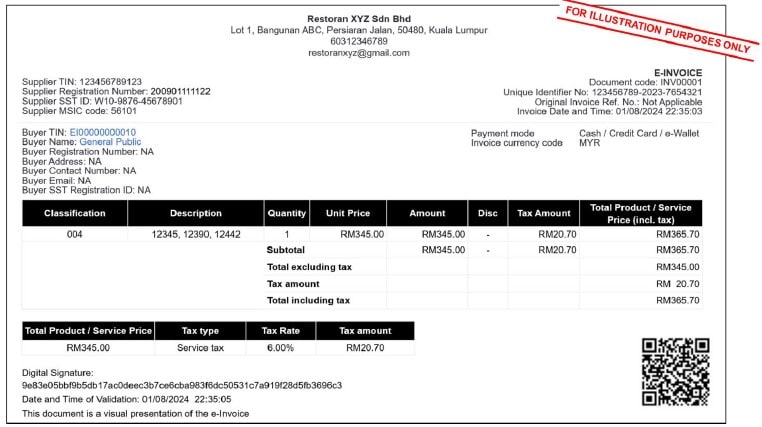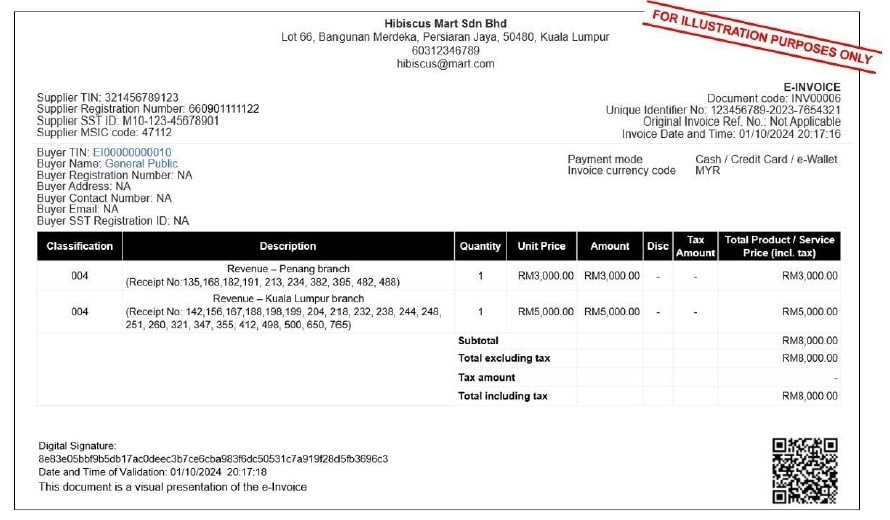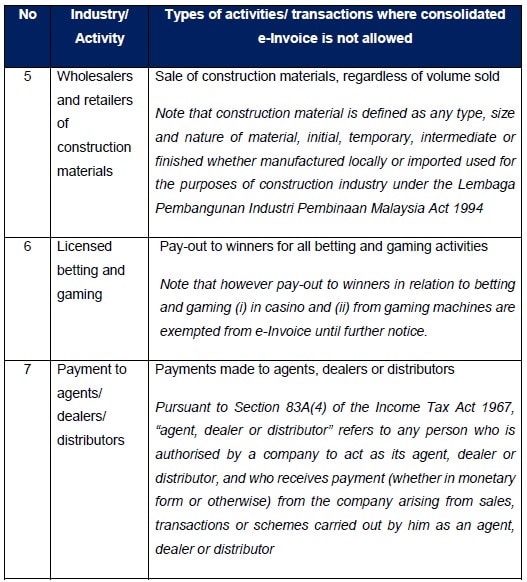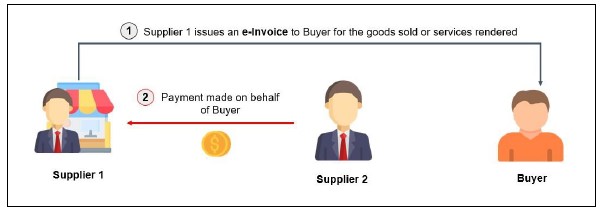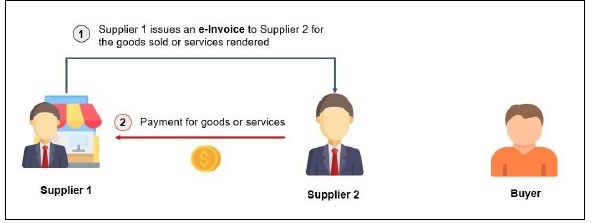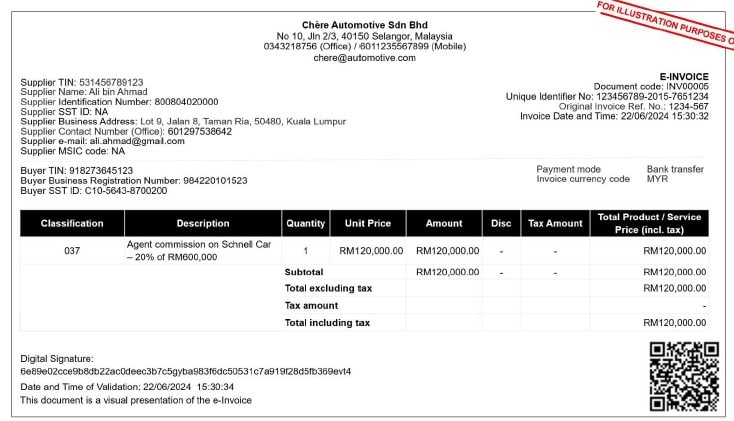This post is also available in:
Melayu (Malay)
简体中文 (Chinese (Simplified))
Understand Malaysia e-Invoice
To support the growth of the digital economy, the Government intends to implement e-Invoice in stages in an effort to enhance the efficiency of Malaysia’s tax administration management. It is in line with the Twelfth Malaysia Plan, where the focus is on strengthening the digital services infrastructure and digitalising the tax administration.
The e-Invoice will enable instant or near-instant validation and storage of transactions, catering to Business-to-Business (B2B), Business-to-Consumer (B2C) and Business-to-Government (B2G) transactions.
The Inland Revenue Board (IRB) has uploaded the E-Invoicing Guideline Year 2023 in its official portal as a reference and guide to taxpayers covering the scope as follows:
- E-invoicing implementation concept;
- E-invoicing implementation timeline;
- The process of issuing and submitting e-invoices to IRB;
- Taxpayer readiness assessment guide; and
- Specification of required data fields.
The Inland Revenue Board (IRB) has further issued e-Invoice Guideline and e-Invoice Specific Guideline.
It contains updates such as persons exempted from issuing e-Invoice, e-Invoice validation, rejection/cancellation of e-Invoice, and data fields for e-Invoice and annexure to e-Invoice, amongst others.
e-Invoice Specific Guideline to specifically explain the following transactions:-
- Transactions with buyers
- Statements or bills on a periodic basis
- Disbursement and reimbursement
- Employment perquisites and benefits
- Certain expenses incurred by the employee on behalf of the employer
- Self-billed e-Invoice
- Transactions that involve payments in monetary form to agents, dealers or distributors
- Cross-border transactions
- Profit distribution
- Foreign Income
- Currency exchange rates
- Application Programming Interface (API) overview, and
- Cybersecurity
Taxpayers can access and download these guidelines along with questions (FAQ) through the link https://www.hasil.gov.my/en/e-invoice/
e-Invoice Implementation Timeline
As announced by the Inland Revenue Board (LHDN), e-Invoicing will be implemented in phases starting from 1 August 2024, with deadlines based on a business’s audited annual revenue. All businesses must assess their financial position and prepare accordingly to ensure timely compliance.
|
Phase |
Annual Revenue / Sales |
Implementation Date |
|
Phase 1 |
> RM100 million |
1 August 2024 |
|
Phase 2 |
> RM25 million – RM100 million |
1 January 2025 |
|
Phase 3 |
> RM5 million – RM25 million |
1 July 2025 |
|
Phase 4 |
> RM1 million – RM5 million |
1 January 2026 |
|
Phase 5 |
> RM500,000 – RM1 million |
1 July 2026 |
How to Determine Your E-Invoice Start Date
Your company’s e-Invoice implementation date is based on the Audited Financial Statements (AFS) for the Financial Year Ending 2022. If unavailable, refer to FYE 2023, and so on.
The calendar year is not used. Only financial year-end revenue applies. For example, if your audited revenue for FYE 2022 is RM6 million, your start date falls under Phase 3: 1 July 2025.
Exemption Criteria for Companies Below RM500,000
Companies with audited annual revenue below RM500,000 are exempted from e-Invoice requirements, they can continue using current invoicing practices. However:
- Businesses must reassess at every financial year-end whether they exceed the RM500,000 threshold.
- If a company’s revenue exceeds RM500,000 in FYE 2026, it must begin e-Invoicing from 1 January 2028 (i.e., the second year after crossing the threshold).
Special Rule: Combined Revenue Applies to Sole Proprietors and Related Companies
Even if individual entities earn below RM500,000, e-Invoice becomes mandatory if any of the following apply:
- The company has a corporate shareholder with revenue above RM500,000.
- It is a subsidiary of a holding company with revenue above RM500,000.
- It has a related company or joint venture exceeding RM500,000.
- For sole proprietorships or partnerships, the combined revenue under the same owner exceeds RM500,000.
6-Month Interim Relaxation Period for E-Invoice Compliance
To support businesses during the transition, each implementation phase comes with a 6-month interim relaxation period. If a business is not ready to issue individual e-Invoices or self-billed e-Invoices, the LHDN allows for a consolidated monthly approach:
- Issue a monthly consolidated e-Invoice for all sales transactions.
- Issue a monthly consolidated self-billed e-Invoice for purchase or expense transactions that fall under approved scenarios (as stated in Section 8.3 of the e-Invoice Specific Guidelines), such as: goods or services received from foreign suppliers, transactions with individuals, payments to agents, dealers, or distributors.
- There is no requirement to share validated consolidated e-Invoices with your customers or suppliers during this time.
E-Invoice treatment of transaction exceeding RM10,000
From 1 January 2026, transaction that exceeds RM10,000 is not allowed to be included in the consolidated e-Invoice.
e-Invoice Overview Workflow
Picture below demonstrates an overview of the e-Invoice workflow from the point a sale is made or transaction undertaken, and an e-Invoice is issued by the supplier via MyInvois Portal or API, up to the point of storing cleared e-Invoices on IRB’s database for taxpayers to view their respective historical e-Invoices.
e-Invoice Model
To facilitate taxpayers’ transition to e-Invoice, IRB has developed two distinct e-Invoice transmission mechanisms:
a. A portal (MyInvois Portal) hosted by IRB; and
b. Application Programming Interface (API).
Taxpayers can select the most suitable mechanism to transmit e-Invoice to IRB, based on their specific needs and business requirements.
|
No.
|
Mechanism
|
Key Features
|
Considerations
|
| 1. |
MyInvois Portal
|
Enables individual generation through a comprehensive form and the option for batch generation through spreadsheet upload for processing multiple transactions
|
|
| 2. |
API
|
Enables businesses to conveniently transmit high-volume of transactions
|
|
Mandatory and Optional Fields for e-Invoice
Appendices 1 and 2 of the E-Invoicing Guideline set out a list of required and optional fields for an e-Invoice and annexure to an e-invoice. Taxpayers are free to include additional fields, where required.
Assessing Readiness of e-Invoice
To ensure that businesses are ready for the implementation of e-Invoice in the upcoming months, here are a few key steps that can be carried out to assess readiness and standardisation:
- Allocate and equip personnel with the necessary capabilities to adopt and oversee the implementation of e-Invoice;
- Determine availability of data sources and structure, current IT capabilities to support system readiness and processes to comply to e-Invoice requirements and obligations; and
- Review current processes in issuing transaction documents (i.e., invoice, debit note, credit note, refund note).
E-invoicing process
Figure below provides an overview of invoicing process.
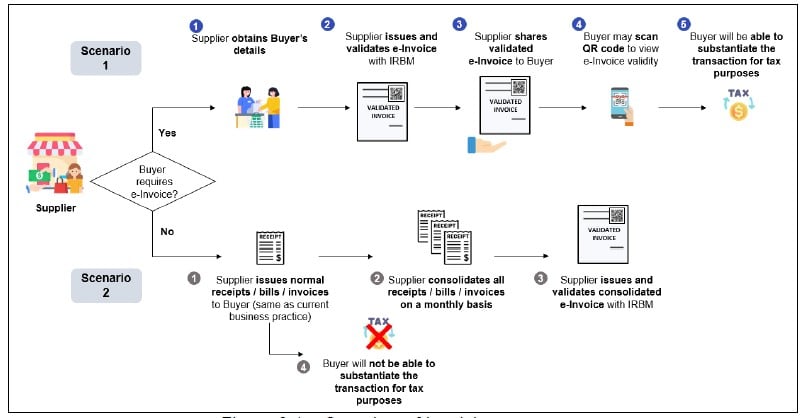
Step 1: Supplier seek confirmation from Buyer if an e-Invoice is required.
Step 2: If the Buyer confirmed that he/ she requires an e-Invoice, the Buyer is required to furnish the Supplier with the required information to facilitate the issuance of e-Invoice.
Step 3: The Supplier is required to complete the remaining required fields as outlined in Appendices 1 and 2 of e-Invoice Guideline and proceed to issue an e-Invoice.
Step 4: The validated e-Invoice can be used as the Buyer’s proof of expense, to substantiate a particular transaction for tax purposes.
Scenario 2: Where the Buyer does not require an e-Invoice
Step 1: Supplier to seek confirmation from Buyers if e-Invoice is required.
Step 2: If Buyers confirmed that no e-Invoice is required, Supplier would continue to issue receipt/ bill/ invoice to the Buyers (same as current business practice).
Step 3: Within seven (7) calendar days after end of the month, Supplier will retrieve the details of all the receipts/ bills/ invoices that were issued for the previous month and issue a consolidated e-Invoice as proof of Supplier’s income.
Step 4: The Supplier will issue the consolidated e-Invoice as per the required fields as outlined in Appendices 1 and 2 of e-Invoice Guideline.
- Once the consolidated e-Invoice has been validated, IRBM will send notification to the Supplier only. Consequently, there would not be any request for rejection from Buyer.
- The validated e-Invoice will serve as the Supplier’s proof of income. Hence, the validated e-Invoice is not required to be shared with Buyer.
Consolidated e-Invoice
Suppliers may consider the following consolidation methods:-
(a) The summary of each receipt/ bill/ invoice is presented as separate line items in the consolidated e-Invoice. Example:
(b) The summary of all the receipts/ bills/ invoices is presented as a single line item in the consolidated e-Invoice. Example:
(c) Each branch or location will submit a consolidated e-Invoice, adopting either (a) or (b) above for the receipts/ bills/ invoices issued by the said branch or location.
(d) The summary of all the receipts/ bills/ invoices issued by each branch or location is presented as separate line items in the consolidated e-Invoice. Example:
*Note that for any method adopted by businesses, the receipt/ bill/ invoice reference number for each transaction are required to be included under this field in the consolidated e-Invoice.
Certain activities that require e-Invoice to be issued for each transaction (i.e., consolidation of e-Invoice is not allowed)
Overview of methods for Suppliers to issue e-Invoice to Buyers
Note that the examples described below are suggestions provided for Suppliers’ consideration. Suppliers are allowed to adopt and implement any method to comply with e-Invoice requirements and improve their customers’ experience.
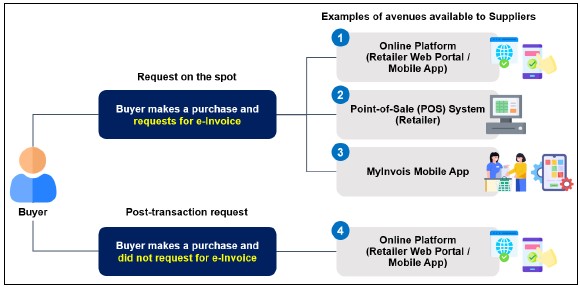
STATEMENTS OR BILLS ON A PERIODIC BASIS
- Currently, certain businesses/ industries/ sectors practice the issuance of statements or bills to record multiple transactions between Supplier and Buyer (e.g., businesses, end consumers, etc.) over a set period of time (e.g., monthly, bi-monthly, quarterly, bi-annually, annually), instead of issuance of individual invoices for each transaction. These industries/ sectors include but not limited to:
- (a) Digital/ Electronic payment
- (b) Financial services, including banking and financial institutions
- (c) Healthcare
- (d) Insurance
- (e) Stockbroking
- (f) Telecommunications
- Upon the implementation of e-Invoice, Suppliers are required to issue e-Invoice as proof of income. To minimise business disruption, IRBM allows Suppliers that issue statement/ bill on a periodic basis to issue e-Invoice in the format of XML or JSON for IRBM’s validation and convert the validated e-Invoice into visual presentation in the form of statements/ bills, to be sent to Buyers.
DISBURSEMENT OR REIMBURSEMENT
- Reimbursements refers to out-of-pocket expenses incurred by the payee in the course of rendering services or sale of goods to the payer (i.e., Buyer), which are subsequently reimbursed by the payer. Such expenses include the cost of airfare, travelling, accommodation, telephone and photocopying charges.
- Disbursements are out-of-pocket expenses incurred by the payer (i.e., buyer) and paid to a third party (on behalf of the payer) by the payee in connection with services rendered or sale of goods by the payee to the payer.
Scenario 1: Supplier 1 issues e-Invoice to Buyer
Step 1: Supplier 2 entered into an agreement with Buyer for supply of goods or provision of services. As part of the arrangement, Supplier 2 will make payment on behalf of Buyer to settle any expenses incurred during the contract period.
Step 2: Upon concluding a sale or transaction, Supplier 1 will issue an e-Invoice directly to the Buyer as per the required fields as outlined in Appendices 1 and 2 of e-Invoice Guideline and submit it to IRBM for validation.
Step 3: Supplier 2 will make payment on behalf of Buyer to Supplier 1 to settle the outstanding amount. Supplier 1 will issue payment proof to Supplier 2 for the settlement.
Step 4: Supplier 2 will issue an e-Invoice to the Buyer for the goods supplied or services rendered by Supplier 2 to buyer (the process of issuing e-Invoice is similar to Step 2 above). Supplier 2 should neither include the payment made on behalf of Buyer in Supplier 2’s e-Invoice nor issue an additional e-Invoice for it.
Supplier 2 provides payment proof to the Buyer to recover the payment made to Supplier 1 on behalf of the Buyer.
Scenario 2: Supplier 1 issues e-Invoice to Supplier 2
Step 1: Supplier 2 entered into an agreement with Buyer for supply of goods or provision of services. As part of the arrangement, Supplier 2 will make payment on behalf of buyer to settle any expenses incurred during the contract period.
Step 2: Upon concluding a sale or transaction, Supplier 1 will issue an e-Invoice to Supplier 2 as per the required fields as outlined in Appendices 1 and 2 of e-Invoice Guideline and submit it to IRBM for validation.
Step 3: Supplier 2 will make payment to Supplier 1. Supplier 1 will issue payment proof to Supplier 2 for the settlement.
Step 4: Supplier 2 will issue an e-Invoice to the Buyer (similar as per Step 2 above) to record the amount incurred on behalf of Buyer (e.g., disbursement/ reimbursement) alongside with the goods sold or service rendered by Supplier 2, which will be presented as separate line items in the e-Invoice.
EMPLOYMENT PERQUISITES AND BENEFITS
- It may include benefits in cash or in kind that are received by an employee from the employer or third parties in respect of having or exercising the employment, such as:
(a) Employees’ pecuniary liabilities (e.g., utility bills, parking fees, and car maintenance charges)
(b) Club membership
(c) Gym membership
(d) Professional subscriptions
(e) Allowances (e.g., travelling allowance, petrol allowance or toll rate, parking rate/ allowance, meal allowance)
- Where employees are allowed to claim such expenses from his/ her employer, employees are required to prove the authenticity of such expense with supporting documents (e.g., bills, receipts, invoices, statements, payment slips, etc.).
- Upon implementation of e-Invoice, employees are required to request for the e-Invoices to be issued to their employer for proof of expense, to the extent possible.
- IRBM recognises the potential challenges in getting e-Invoice to be issued in the name of the employer (as Buyer). In this regard, the IRBM provides the following concession:
- (a) Businesses will be allowed to proceed with the use of e-Invoice issued in the name of the employee to support the particular transactions as proof of expense for tax purposes.
- (b) In the event where payment is made to foreign suppliers, both employer and employee are not required to issue a self-billed e-Invoice. As such, IRBM will accept foreign supplier’s receipts/ bills/ invoices as a proof of expense.
SELF-BILLED E-INVOICE
For e-Invoice purposes, self-billed e-Invoice will be allowed for the following transactions:
(a) Payment to agents, dealers, distributors, etc.
(b) Goods sold or services rendered by foreign suppliers
(c) Profit distribution (e.g., dividend distribution)
(d) e-Commerce transactions
(e) Pay-out to all betting and gaming winners (in casino and from gaming machines are exempted from self-billed e-Invoice until further notice)
(f) Acquisition of goods or services from individual taxpayers (who are not conducting a business)
Where a Buyer is required to issue a self-billed e-Invoice, the Buyer will assume the role of the Supplier to be the issuer of e-Invoice and submits it to IRBM for validation. Upon validation, Buyer would be able to use the validated e-Invoice as a proof of expense for tax purposes.
PAYMENTS IN MONETARY FORM TO AGENTS, DEALERS OR DISTRIBUTORS
General overview of payment to agent, dealer or distributor:
- When a Purchaser acquires goods or services from the Seller through an Agent/ Dealer/ Distributor, Seller is required to issue an e-Invoice to the Purchaser to record the transaction.
- Where the Purchaser does not request for an e-Invoice to be issued, Seller will issue a normal receipt/ bill/ invoice to the Purchaser. Subsequently, Seller is required to issue a consolidated e-Invoice, aggregating all receipts/ bills/ invoices issued for the prior month, for proof of income within seven (7) calendar days after the month-end.
- Upon concluding a sale or transaction, the Agent/ Dealer/ Distributor is eligible to receive a payment from the Seller (e.g., commission).
- For the purpose of self-billed e-Invoice issuance, the roles of both parties would be as follows:
- (a) Supplier: Agent/ Dealer/ Distributor
- (b) Buyer: Seller (assumes the role of Supplier to issue a self-billed e-Invoice for proof of expense)
- Example for Issuance of self-billed e-Invoice from Seller to Agent/ Dealer/ Distributor: Ali works as a sales agent of Chère Automotive Sdn Bhd (CASB). On 22 June 2024, Ali sold a car (Schnell model) at a price of RM600,000 and earns a 20% commission on the sales he made. CASB issues a self-billed e-Invoice to Ali, recording the 20% commission earned by Ali as proof of income and proof of expense for CASB. Below is an example of a self-billed e-Invoice issued by CASB to Ali:
CROSS BORDER TRANSACTIONS
- Cross-border transaction involves a transaction between a Malaysian buyer and a foreign supplier and vice versa.
- Goods sold or services rendered by Foreign Seller to Malaysian Purchaser: Given that the Foreign Seller is not mandated to implement Malaysia’s e-Invoice, the Malaysian Purchaser is required to issue a self-billed e-Invoice to document the said expense. A self-billed e-Invoice is required to support the said transaction for tax purposes.
- Goods sold or services rendered by Malaysian Seller to Foreign Purchaser: Upon the implementation of e-Invoice, Malaysian Seller is required to issue an e-Invoice to the Foreign Purchaser to record the said income.
PROFIT DISTRIBUTION (E.G., DIVIDEND DISTRIBUTION)
- Domestic Distribution
- Currently, companies distributing profits to its shareholders issues dividend vouchers or dividend warrants to its shareholders
- Upon implementation of e-Invoice in Malaysia, companies that are not entitled to deduct tax under Section 108 of the Income Tax Act 1967 as well as taxpayers who are listed on Bursa Malaysia will be exempted from issuing self-billed e-Invoice on dividend distribution. Correspondingly, their shareholders are not required to issue an e-Invoice for proof of income.
- However, taxpayers other than those mentioned in Section 11.1.2 are required to issue self-billed e-Invoice to document the expense. Similarly, the self-billed e-Invoice will serve as a proof of income for the Supplier (i.e., recipients of the profit distribution).
- Foreign Profits/ Dividend
- For any foreign profits/ dividend received in Malaysia, the recipient is required to issue an e-Invoice to document as a proof of income for tax purposes.
- For the purposes of e-Invoice issuance, the roles of both parties would be as follows:
- (a) Supplier: Profit/ Dividend Recipient
- (b) Buyer: Foreign Distributor
FOREIGN INCOME
- An e-Invoice would be required for all foreign income received in Malaysia from outside Malaysia as a proof of income for tax purposes.
- For the purposes of e-Invoice issuance, the roles of both parties would be as follows:
- (a) Supplier: Recipient of the foreign Income
- (b) Buyer: Person who makes payment to Income Recipient
- The Income Recipient should issue the e-Invoice latest by the end of the month following the month of receipt of the said foreign income.
If you require assistance with e-invoicing, feel free to reach out to 3E Accounting today. We are here to provide you with the support you need.
